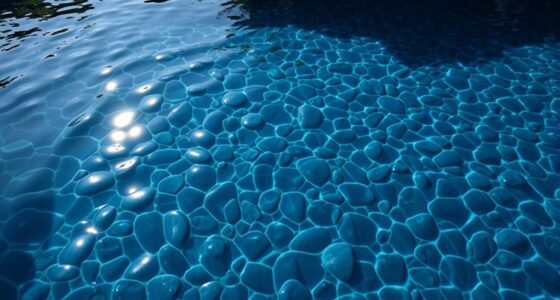3D-printed pool components are revolutionizing construction by offering fast, customizable solutions that improve design flexibility and sustainability. You can choose materials suited for specific climates and aesthetics, resulting in durable, high-performance parts. This technology speeds up project timelines and reduces costs with on-demand production and minimal waste. If you keep exploring, you’ll discover how this innovative approach can transform your pool construction experience.
Key Takeaways
- 3D printing enables rapid, customized production of complex pool components, reducing construction time.
- Material selection supports durable, eco-friendly components tailored to specific climate and aesthetic needs.
- Advanced manufacturing allows innovative, intricate designs not feasible with traditional methods.
- On-site or nearby production streamlines logistics and minimizes waste, promoting sustainable construction.
- Shortened project timelines and reduced costs enhance overall efficiency in pool construction projects.

Have you ever considered how 3D printing is transforming pool construction? This innovative technology is opening up new possibilities for creating customized, durable, and efficient pool components. One of the most substantial advantages of 3D printing in this industry is material customization. Unlike traditional manufacturing methods, which often limit you to pre-selected materials and designs, 3D printing allows you to tailor components precisely to your specifications. Whether you need a specific type of plastic, composite, or even metal, the technology can adapt to meet these needs. This flexibility means you can select materials that are better suited for your climate, aesthetic preferences, or structural requirements. This material versatility enables you to optimize pool components for longevity and performance, reducing the need for costly repairs or replacements down the line.
Another key benefit is manufacturing speed. Traditional pool construction can involve lengthy processes, from casting to assembly, often taking weeks or even months. With 3D printing, you can considerably cut down on production time. Once the design is finalized, the printing process can generate complex parts in a matter of hours or days, not weeks. This rapid manufacturing speed means you can accelerate your entire project timeline, reducing labor costs and minimizing disruptions. Plus, 3D printing allows for on-demand production, which means you don’t need to wait for parts to be shipped from distant factories. Instead, you can produce components directly on-site or nearby, streamlining logistics and further speeding up the construction process.
The ability to quickly produce customized parts also enhances the entire design process. You can experiment with complex geometries and intricate details that traditional methods might struggle to produce efficiently. This capability enables more innovative, aesthetically appealing pools that stand out. Additionally, 3D printing can enable just-in-time manufacturing, reducing waste and inventory costs because you print only what you need when you need it. This eco-friendly aspect not only benefits the environment but also helps you stay within budget.
Frequently Asked Questions
What Are the Cost Comparisons Between Traditional and 3d-Printed Pool Parts?
You’ll find that 3D-printed pool parts typically have lower material costs and reduce labor expenses compared to traditional methods. While initial setup might be higher, the faster production and less manual work save money in the long run. You’ll benefit from quicker installation and fewer staffing needs, which overall makes 3D printing a cost-effective choice for pool construction.
How Durable Are 3d-Printed Pool Components Over Time?
You’ll be pleased to know that 3D-printed pool components generally maintain excellent durability, with some materials lasting over 10 years. While material degradation can occur, advances in printing technology and high-quality materials improve long-term performance. Proper maintenance and choosing the right filament considerably extend lifespan, ensuring your pool remains sturdy and safe. Overall, 3D-printed parts offer a promising balance of durability and innovation for pool construction.
Can 3D Printing Customize Pool Designs Effectively?
Yes, 3D printing can effectively customize pool designs thanks to its design flexibility and material diversity. You can create intricate shapes, unique features, and personalized details that traditional methods struggle to achieve. With a variety of printable materials, you’re not limited to standard designs, allowing you to tailor every aspect of your pool’s look and structure precisely to your preferences, making your dream pool a reality.
What Environmental Impacts Are Associated With 3D Printing Pool Components?
You might wonder about the environmental impacts of 3D printing pool components. It can generate plastic waste if materials aren’t recycled properly, and energy consumption is often high due to the printing process. While it reduces material waste compared to traditional methods, you should consider these factors to minimize environmental harm. Using sustainable materials and energy-efficient printers helps you lessen the negative effects on the environment.
Are 3d-Printed Pool Parts Compatible With Existing Construction Materials?
You’ll find that 3D-printed pool parts are generally compatible with existing construction materials, but careful attention to material compatibility is essential. You might face installation challenges, such as ensuring proper bonding and structural integrity. It’s important to verify that the 3D-printed components match the properties of traditional materials to prevent issues. With proper planning, integrating these innovative parts can be smooth and efficient, enhancing your pool construction process.
Conclusion
As you explore the world of 3D-printed pool components, remember that innovation is the key to transforming construction. Imagine a future where every pool is uniquely tailored and built faster than ever—it’s like turning the page to a new chapter of possibility. Embrace this technology, for it’s not just shaping pools but redefining how we create our dreams. The question is, are you ready to plunge into this exciting new wave?









